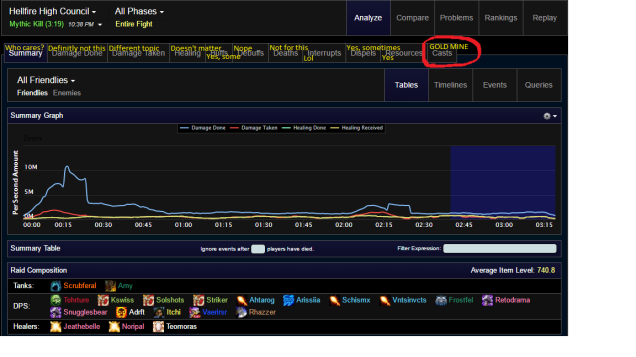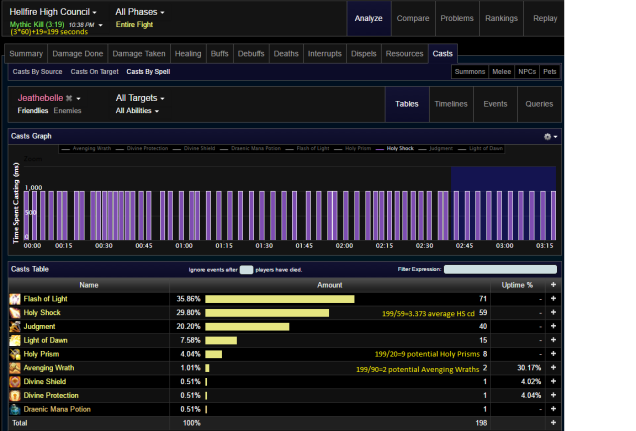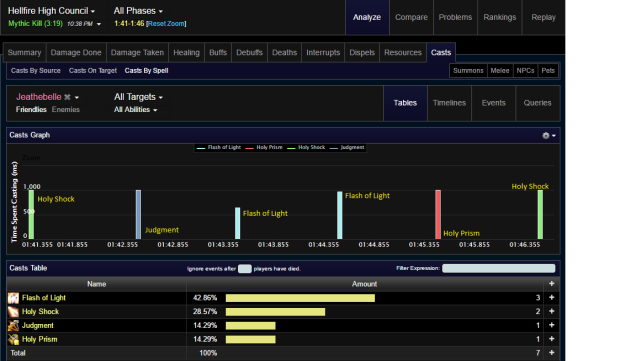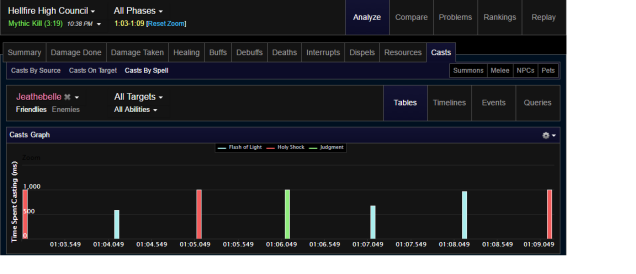Who You Gonna Believe, Warcraft Logs or Your Own Lying Memory?
When you drove home today, how many times was the traffic light green? Last time you wrote an email, how often did you need to backspace due to a typing error? In your last raid, how many holy shocks did you miss?
Your memory is a manipulative, self-centered prima donna. It’ll color over mistakes, bury things that made you feel bad, disregard the routine as not worth dwelling on. You are the hero in the story you are constantly telling yourself about yourself, and your memory will unabashedly lie to you to support that story.
This is especially true in activities like driving, typing, and raiding in World of Warcraft. All of these bypass the conscious-thinking-observer in you. Your conscious thinker is simply too slow to effectively decide “and next I’ll type w, and then i, and then n, and bam now I WIN.” Instead, the vast majority of decisions you make in these activities are are reflexive, based on pre-programmed responses. You pre- and post-think, consciously deciding how to respond to a situation; then practice until your chosen response in that situation is ingrained by repetition (this is why you eventually stopped wiping on Mannoroth!)
This has many implications for thoughtful raiding, one of which (today’s topic!) is that you generally won’t remember small, mechanical mistakes you made during the raid. (You also won’t remember big mistakes, often blaming the effects on others, but that’s a topic for another time). Since you won’t remember them, you won’t think about them, you won’t fix them, and you’ll certainly repeat them. One of the best ways to improve your gameplay is to identify mistakes you’ve made. Then you can practice ways to avoid that mistake outside of a raid encounter, taking the time to program your reflexes to correctly respond to the scenario that previously caused you to err.
There is no better tool for identifying mistakes than Warcraft Logs. Bypass all of your cognitive biases and look at actual data.
And You Thought The First Part of This Post Was Long: What to Look For In Your Holy Paladin Logs
My favorite fight for looking at Holy Paladin fundamentals is High Council. Long enough for mistakes to develop, minimal movement, mostly a turret-and-heal fight. Of course there is value to looking at high-movement fights as well, to see how well you handle movement while maximizing casting, but for now I’ll focus on casting fundamentals.
1. Look at what you cast, not how much you healed.
So pull up your Council log and look at your healing.
What are you doing!? Not the healing tab. Who cares how much healing you did compared to the other healers? That’s completely irrelevant. We’re doing this to find mistakes, not to let our story-telling ego lie to us even more. Looking at your own healing-done breakdown is just as useless. Especially for a Holy Paladin, how much healing you have from Illuminated Healing, Beacon, and direct heals will vary wildly depending more on the encounter and your raid comp than on your own mistakes and successes.
By far the best, most useful information is in the casts tab. Almost every mechanical error in Holy Paladin play is best identified by this information.
First, you can run some basic numbers. Multiply the minutes the fight took by 60 and add the remaining seconds to get how many total seconds the encounter lasted. Then you can figure your average cooldown on Holy Shock, as well as how many times you could have cast Holy Prism and Avenging Wrath.
2. How many Holy Prisms did you miss, & was it on purpose?
Missing a few potential Holy Prisms is ok. If you delay it an average of 5 seconds to line it up with actual damage instead of using it for pure Illuminated Healing overheal, by the end of a 5 minute fight you’ll have missed out on 3 uses. But if you’re actually healing damage with the Prism splash, you’ll have gained more effective healing (and done your raid more good) than you lost from forgoing the pure Illuminated Healing from casting it on cooldown by rote.
Here I missed 1 potential Holy Prism cast. So let’s zoom in to the actual casts to see if that was just cumulative minor delays (ok) or a large gap (mistake). De-select every cast but Holy Prism in the casts graph.
 As you can see here, I delayed my first Prism for 25 seconds, meaning if I’d cast it in the first 5 seconds I would still have had the cast at 25 seconds–i.e. I missed an entire cast for no good reason. Mistake! Then I also delayed for 14 seconds after my second Prism. Eliminating that delay would not have gotten me an extra cast, so it didn’t lose me anything–but if the fight had been a few seconds longer it would have! This was definitely a mistake too; just one whose consequences didn’t materialize.
As you can see here, I delayed my first Prism for 25 seconds, meaning if I’d cast it in the first 5 seconds I would still have had the cast at 25 seconds–i.e. I missed an entire cast for no good reason. Mistake! Then I also delayed for 14 seconds after my second Prism. Eliminating that delay would not have gotten me an extra cast, so it didn’t lose me anything–but if the fight had been a few seconds longer it would have! This was definitely a mistake too; just one whose consequences didn’t materialize.
You should also click on Holy Prism in your cast list, and verify you never accidentally cast it at a friendly target. Holy Prism does far more healing when cast at an enemy, so I have a macro that doesn’t even permit me to cast it at a friendly. If your logs show you cast Prism at a friendly target, consider implementing a similar macro.
3. Never, ever, I mean never delay Avenging Wrath.
Missing an Avenging Wrath cast is much less ok! AW is an enormous healing boost on a short cooldown; if you delayed it too long and lost a use, figure out how to squeeze in another use. The caveat here is that you want to plan the uses around actual raid damage. But that is fairly easy to do, even while using it on cooldown (or nearly so) because Avenging Wrath lasts 30 seconds–far longer than most scripted damage events.
Holy Shock is Love, Holy Shock is Life
Now let’s get to the meat of Holy Paladin mechanics: Holy Shock. Between the Libram of Vindication and Infusion of Light, Holy Shock is the engine of our HPS. Every missed or delayed Holy Shock is a mistake. Zoom in on your Holy Shock casts and get comfortable–we’re gonna spend some time here.
1. Identify when and why you delayed Holy Shock.
Earlier, when we looked at overall casts, we calculated our average Holy Shock cooldown. A 3.37 second average Holy Shock cooldown is really low, which is great. But be aware that fight length has a huge impact on your average HS cd. The shorter the fight, the larger the impact Bloodlust will have; a very short fight with high Bloodlust uptime will naturally drastically reduce your HS cd. When I do log reviews, I typically suggest that an average Holy Shock cooldown of 4.5 seconds or less is a good benchmark to target, and less than 4.0 is very good.
To identify where you mistakenly delayed your Holy Shocks, first find the sweet spot: where your Holy Shocks look like lovely metronomed beats, or perfectly spaced fence posts. That’s the goal, and a good baseline for figuring out if you have any delay errors.
 Looking at the prettiest portions of my Holy Shock fence–when I’m almost perfectly executing the HS-Judge-Fol-FoL rotation and the HS cooldown is not being reduced by Bloodlust or Avenging Wrath–my Holy Shocks are exactly 4 seconds apart. That means if I find any gaps longer than 4 seconds, I made a mistake.
Looking at the prettiest portions of my Holy Shock fence–when I’m almost perfectly executing the HS-Judge-Fol-FoL rotation and the HS cooldown is not being reduced by Bloodlust or Avenging Wrath–my Holy Shocks are exactly 4 seconds apart. That means if I find any gaps longer than 4 seconds, I made a mistake.
Looking at all the gaps that look larger than the metronome 4 second intervals, its fairly easy to find mistakes: here, two 5 second gaps, each a 1 second delay on Holy Shock. If the fight were longer, or there are a few 0.5 second delays, it could have added up to another Holy Shock cast. So let’s zoom in on one and take a look to see what caused that mistake.
After zooming in, the mistake is obvious: I cast Holy Shock, Judgment, Flash of Light, Flash of Light. So far so good. But then I delayed the Holy Shock, which was by then off cooldown, by casting Holy Prism instead. Instead, I should have substituted that Holy Prism for the second Flash of Light.
2. Verify you aren’t wasting Holy Shock buffs: Libram & IoL.
You’ve read the Selfless Healer guide, so you know you should always cast Flash of Light after each Holy Shock to consume the Libram of Vindication buff doubling the heal, as well as the potential Infusion of Light increasing it still further. But did you accidentally cast Holy Shock twice without casting a Flash of Light between them? It’s not uncommon. So now select both Holy Shock and Flash of Light on the casts graph, and verify that every single Holy Shock has at least one Flash of Light cast before the next HS.
Be especially careful to check that you properly handled Enhanced Holy Shock procs, by zooming in if necessary. Zooming in to verify the Enhanced Holy Shocks are each followed by Flash of Lights is helpful, because on the full-length chart it is difficult to see the Flash of Light cast between the adjacent Holy Shocks.
In this example, both Holy Shocks are followed by a Flash of Light before the next HS cast. Additionally, the Enhanced Holy Shock proc was properly handled to minimize the delay between the two Holy Shocks, while still consuming the buff, by skipping Judgment after the first, no-cooldown, Holy Shock.
3. Ensure you adjusted your rotation during Bloodlust and Avenging Wrath.
During Bloodlust and Avenging Wrath (and especially when both are combined) your Holy Shock cooldown is significantly reduced. Zoom in to look at your cast sequences during those buffs, and verify you are casting properly to avoid delaying Holy Shock even with its reduced cooldown. You can check when you had the buff under the Buffs tab of Warcraft Logs, then zoom in to that interval and swap to your Casts tab to see what you cast during your uptime.
Check with the guides if you’re unsure what cast sequence you should be using to avoid delaying Holy Shock while under the effects of different haste buffs.
Details, Details: Mana, Holy Power, Defensives & Potions
1. Did you spend all your mana, or end up with wasted mana at the end of the fight?
Any mana you have left at the end of the fight is wasted mana, that you could have converted to healing during the encounter. And unless the fight is incredibly short, it is possible to burn through your mana. If you’re specced Eternal Flame, cast less Holy Light and more Flash of Light to burn mana. If you’re Selfless Healer, skip Judgment a few times and substitute in a third Flash of Light; you’ll quickly notice the depleting mana.
Click on the Resources tab, and select yourself and the mana resource. Regardless of fight length, you want your mana to look much like this chart.
2. Did you manage your Holy Power effectively?
Holy Power management is one of the most common minor errors I see, even in my own logs and in other high-end raiding Holy Paladins. Swap the resource you are looking at to Holy Power and take a look.
First, note that “wasted” Holy Power–continuing to cast Holy Shock when already capped at 5 Holy Power–is usually not a bad thing. If Bloodlust and Avenging Wrath are up, for example, you can cast Holy Shock or a Holy Shock-buffed Flash of Light every single GCD; inserting a Light of Dawn to spend your Holy Power in that situation is a healing loss. See the guide for details.
However, casting Light of Dawn–or Eternal Flame, or Word of Glory–when at less than 3 Holy Power is a mistake. It is essentially a wasted GCD; you are basically trading healing for a marginal increase in mana. This is an awful trade–try to never do it. If you see on your logs you are making this mistake, consider making a Weakaura or other UI modification to help you avoid casting Holy Power spenders with less than 3 Holy Power.
3. Did you use 2 potions? The correct ones?
You should always drink an Intellect Potion just before the pull. Depending on how good your raiders are at avoiding the deadly pre-pull (link them this tutorial if necessary) you may want to pre-pot at 3 or 2 instead of 1 or 0, so you don’t lose out on your in-combat potion. But there is simply no reason to skip out on a pre-pull Intellect Potion; at the very worst, with no real damage going out during its duration, it’ll help you stack larger Illuminated Healing shields on the tanks. Verify you pre-potted in the Buffs tab.
You should always use a combat potion as well. If you are burning through your mana, drink either a Channeled Mana Potion (if you are sure no mechanic or incoming damage will force you to cancel the drink to move or heal) or an Instant Mana Potion. If you are fine on mana, you should pop another Intellect Potion, ideally stacked with Avenging Wrath and timed with particularly heavy damage.
Your second potion will show up in your Casts tab.
4. Did you appropriately use defensive cooldowns?
I can, have, and probably will write volumes about properly using defensive cooldowns. Especially during progression (but even during farm anytime you are at risk of dying) using defensive cooldowns correctly is an enormous component of successful, high-skill raiding. Use logs to check not only that you cast defensive abilities, but that you got good value from their use.
For example, here I cast Divine Shield once. Find the uptime under the Buffs tab, zoom in to its use, and check the Debuffs and Damage Taken tab to find out why you cast it, and if you got good value.
Here, I used Divine Shield to bubble off 6 stacks of the bleed. If this were progression, I’d consider that an enormous waste of an immunity cooldown–proper movement could have avoided the high stacks and saved the cooldown. But on an easy farm fight, when my hit points never drop below 50%, I’ve consciously decided to use my cooldown to soak the bleed the entire time the caster is alive, so other raiders don’t have to worry about it.
I also cast Divine Protection once. Again, zoom in to the uptime of the buff, then check Damage Taken to see if you got value from the cooldown.
Ooops. Swing and a miss. You’re looking for significant damage taken during the cooldown’s uptime–ideally life-threatening damage taken–and if you don’t see any, look for other times in the fight when your life was endangered and consider making sure you use the cooldown then instead. Take a look at your Hit Points under Resources, then zoom in to the times when your life was most in danger. Check what damage you took during that time, and consider whether you can avoid it or, if not, predict it and use an appropriate cooldown.
What A Novel That Turned Into
Whew! If you read to the end, you deserve a cookie. Have one on me.
Anyone who has read the guides and understands on a cerebral level what they should be doing can use this guide to figure out where their actual performance deviates from the ideal. After that, it’s just a matter of practice! Go stand in your garrison by the training dummies and practice till your muscle memory is correctly trained; then raid again, and log again, and find new mistakes, and…improve ad infinitum.
In my next post, Log Analysis 201, I’ll explain what I look for in evaluating my actual healing performance, as opposed to mechanics execution. Your perfect HS-Judge-FoL-FoL rotation won’t do diddly squat if you’re casting on the wrong targets. Who did you cast on? What did you cast? And who should you actually have been targeting? In our business of saving lives, who you’re healing, and when, matters even more than what you’re casting.


















Thank u for the time u put into helping the Holy Paladin community:)
LikeLike
My pleasure!
LikeLike
I wish this existed before I’d gotten 13/13 – now I’m not sure what to do with it – but an amazing resource nonetheless, thank you.
LikeLike
A lot of useful information! not just specifically for us holy pallies, but for raiders in general – i mean warcraftlogs app is a great thing 🙂
LikeLike
This is wonderful, thank you for sharing!
LikeLike
First of all thanks for writing/sharing this novel. After reading this it encouraged me to start investigating my logs a lot more. I started out with calculating my average cooldown on Holy Shock. Sinds 4.5 seconds or less was a good benchmark to target during WoD (HS had a 6 second CD), does that mean that as a general rule of thumb 6,75 seconds is a good benchmark during Legion (HS now has a 9 second CD)?
LikeLike